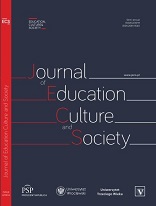Smart learning environments in a contemporary museum: a case study
Smart learning environments in a contemporary museum: a case study
Author(s): Judita Kasperiūnienė, Ilona TandzegolskienėSubject(s): Education, Inclusive Education / Inclusion
Published by: Fundacja Pro Scientia Publica
Keywords: contemporary museum exhibitions;edutainment in a museum;museum narratives;smart museum learning environments;storytelling in the museum
Summary/Abstract: Aim. The modern museum becomes an attractive learning place and space where the visitor, depending on age and competence, develops personal experience, and constructs the learning process based on personalized goals. The article aims to reveal how spaces in museums are exploited, in what ways visitors are involved in a narrative that connects the present and the past. Concept. The research uses a case-study method to investigate the POLIN Museum of the History of Polish Jews (Poland), Ruhr Museum (Germany), and Vienna Technical Museum (Austria). Within the smart learning environment context, this study explains how to encourage museum visitors to learn and seek answers. Results and conclusion. Four main directions are emphasized: the construction of a narrative through the creation of spaces and places, the creation of a historical narrative through simulacra, the educational effect of smart solutions, and the edutainment. The findings show that change in the museum by combining design solutions, historical narrative, time experience, and smart technologies leads to cognitive, engaging learning, touching, feeling, and experiencing different emotions, encouraging a return to the museum, inviting to learn, and shaping one's personal experience. Cognitive value. Contemporary museums invite visitors to a new experience combining artistic space design, storytelling, individual time management, and the use of smart learning environments. These challenges are shifting museum narratives and influencing non-formal learning programs. Authors raise a discussion of how, by exploiting museum spaces, the visitors are involved in the stories, and how the smart learning environment is created in a modern museum.
Journal: The Journal of Education, Culture, and Society
- Issue Year: 11/2020
- Issue No: 2
- Page Range: 353-375
- Page Count: 23
- Language: English

